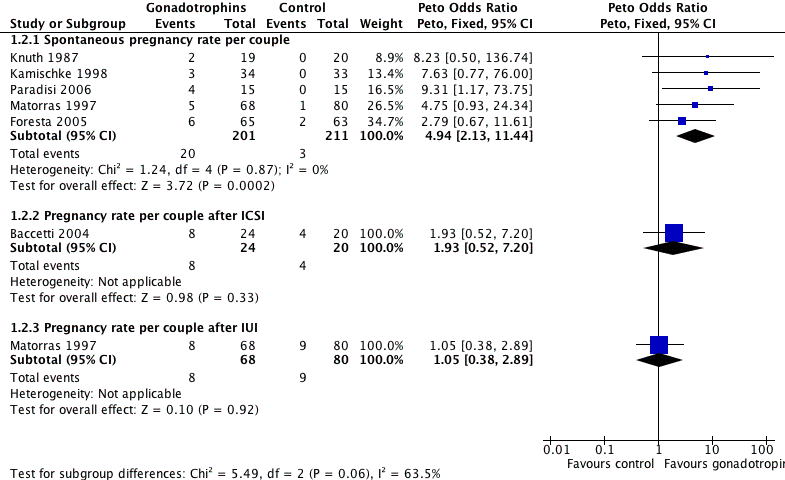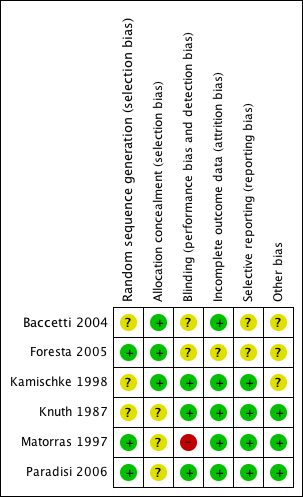Gonadotropinas para la subfertilidad idiopática de factor masculino
Información
- DOI:
- https://doi.org/10.1002/14651858.CD005071.pub4Copiar DOI
- Base de datos:
-
- Cochrane Database of Systematic Reviews
- Versión publicada:
-
- 23 agosto 2013see what's new
- Tipo:
-
- Intervention
- Etapa:
-
- Review
- Grupo Editorial Cochrane:
-
Grupo Cochrane de Ginecología y fertilidad
- Copyright:
-
- Copyright © 2013 The Cochrane Collaboration. Published by John Wiley & Sons, Ltd.
Cifras del artículo
Altmetric:
Citado por:
Autores
Contributions of authors
AMA registered the title and took the lead in writing the text of the protocol. For the review, he was responsible for performing searches of databases for trials, selecting trials for inclusion, independently extracting data and providing quality assessment, performing statistical analyses and interpreting the data.
AMA also had the search revised and rerun in 2007 and in 2013. One study was identified and excluded in 2007.
AMAS revised the review, provided methodological support and commented on the final draft.
HGAl initiated and conceptualised the review topic and shared writing of the protocol. For the review, he was responsible for selecting trials for inclusion, independently extracting data and providing quality assessment; he also commented on drafts of the review.
Sources of support
Internal sources
-
None, Not specified.
External sources
-
No sources of support supplied
Declarations of interest
None known.
Acknowledgements
We would like to acknowledge the work of:
-
Michelle L Proctor, a former Review Group Co‐ordinator of the Cochrane Menstrual Disorders and Subfertility Group. She shared in authoring of the first version of this review by commenting on drafts of the text of the protocol, in particular the search strategy and methods sections. For the first version of the review, she was responsible for resolving disagreements in data extraction and quality assessment; and
-
Marian Showell, the Trials Search Co‐ordinator of the Cochrane Menstrual Disorders and Subfertility Group, who provided us with the main search in major databases in February 2012 and January 2013.
Version history
| Published | Title | Stage | Authors | Version |
| 2013 Aug 23 | Gonadotrophins for idiopathic male factor subfertility | Review | Abdelhamid M Attia, Ahmed M Abou‐Setta, Hesham G Al‐Inany | |
| 2007 Oct 17 | Gonadotrophins for idiopathic male factor subfertility | Review | Abdelhamid M Attia, Hesham G Al‐Inany | |
| 2006 Jan 25 | Gonadotrophins for idiopathic male factor subfertility | Review | Abdelhamid M. Attia, Hesham G Al‐Inany, Michelle Proctor | |
| 2005 Jan 24 | Gonadotrophins for male factor subfertility | Protocol | Abdelhamid Mohamed A. M. A. Attia, Hesham G Al‐Inany, Michelle L Proctor | |
Differences between protocol and review
Types of interventions: In the first protocol, we included only couples who were undergoing IUI/IVF/ICSI, but upon finding some studies that looked for spontaneous pregnancy and others that analysed both spontaneous pregnancies and those after ARTs, we removed this restriction.
Outcome measures: We included pregnancies diagnosed by pregnancy test and removed semen parameters from secondary outcomes, as this is a surrogate outcome that provides no value when compared with pregnancy rate.
Keywords
MeSH
Medical Subject Headings (MeSH) Keywords
Medical Subject Headings Check Words
Female; Humans; Male; Pregnancy;

Forest plot of comparison: 1 Gonadotrophins versus placebo/no treatment for the treatment of idiopathic male subfertility, outcome: 1.2 Pregnancy rate per couple randomly assigned.

Forest plot of comparison: 1 Gonadotrophins versus placebo/no treatment for the treatment of idiopathic male subfertility, outcome: 1.3 Subgroup analysis: pregnancy rate per couple randomly assigned with no female factor.

Methodological quality graph: review authors' judgements about each methodological quality item presented as percentages across all included studies.

Methodological quality summary: review authors' judgements about each methodological quality item for each included study.

Forest plot of comparison: 1 Gonadotrophins versus placebo/no treatment for the treatment of idiopathic male subfertility, outcome: 1.1 live‐birth rate per couple randomly assigned.

Comparison 1 Gonadotrophins versus placebo/no treatment for the treatment of idiopathic male subfertility, Outcome 1 Live birth rate per couple.

Comparison 1 Gonadotrophins versus placebo/no treatment for the treatment of idiopathic male subfertility, Outcome 2 Pregnancy rate per couple.

Comparison 1 Gonadotrophins versus placebo/no treatment for the treatment of idiopathic male subfertility, Outcome 3 Subgroup analysis: Pregnancy rate per couple with no female factor.
| Gonadotrophins versus placebo/no treatment for the treatment of idiopathic male subfertility | ||||||
| Population: Men with idiopathic male factor subfertility Setting: Assisted reproduction | ||||||
| Outcomes | Illustrative comparative risks* (95% CI) | Relative effect | No of participants | Quality of the evidence | Comments | |
| Assumed risk | Corresponding risk | |||||
| Placebo/no treatment for the treatment of idiopathic male subfertility | Gonadotrophins | |||||
| Live birth rate per couple randomly assigned | 0 per 1000 | 0 per 1000 | OR 9.31 | 30 | ⊕⊝⊝⊝ | |
| Spontaneous pregnancy rate per couple randomly assigned | 14 per 1000 | 67 per 1000 | OR 4.94 | 412 | ⊕⊕⊕⊝ | |
| *The basis for the assumed risk is the median control group risk across studies. The corresponding risk (and its 95% confidence interval) is based on the assumed risk in the comparison group and the relative effect of the intervention (and its 95% CI). | ||||||
| GRADE Working Group grades of evidence: | ||||||
| 1Authors did not report on allocation concealment. | ||||||
| Outcome or subgroup title | No. of studies | No. of participants | Statistical method | Effect size |
| 1 Live birth rate per couple Show forest plot | 1 | Peto Odds Ratio (Peto, Fixed, 95% CI) | Subtotals only | |
| 1.1 Live birth rate per couple | 1 | 30 | Peto Odds Ratio (Peto, Fixed, 95% CI) | 9.31 [1.17, 73.75] |
| 2 Pregnancy rate per couple Show forest plot | 6 | Peto Odds Ratio (Peto, Fixed, 95% CI) | Subtotals only | |
| 2.1 Spontaneous pregnancy rate per couple | 5 | 412 | Peto Odds Ratio (Peto, Fixed, 95% CI) | 4.94 [2.13, 11.44] |
| 2.2 Pregnancy rate per couple after ICSI | 1 | 44 | Peto Odds Ratio (Peto, Fixed, 95% CI) | 1.93 [0.52, 7.20] |
| 2.3 Pregnancy rate per couple after IUI | 1 | 148 | Peto Odds Ratio (Peto, Fixed, 95% CI) | 1.05 [0.38, 2.89] |
| 3 Subgroup analysis: Pregnancy rate per couple with no female factor Show forest plot | 5 | Peto Odds Ratio (Peto, Fixed, 95% CI) | Subtotals only | |
| 3.1 Spontaneous pregnancy rate per couple with no female factor | 4 | 264 | Peto Odds Ratio (Peto, Fixed, 95% CI) | 5.00 [1.88, 13.34] |
| 3.2 Pregnancy rate per couple after ICSI with no female factor | 1 | 44 | Peto Odds Ratio (Peto, Fixed, 95% CI) | 1.93 [0.52, 7.20] |

